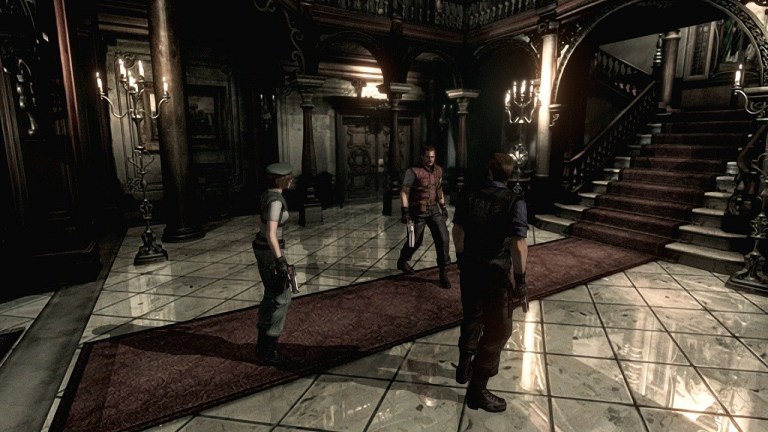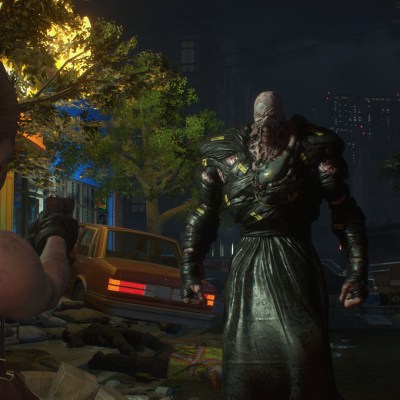How Resident Evil Set the Standard for Video Game Remakes
The GameCube version of Resident Evil forever set a high standard for remakes by acknowledging what made the original great and what made it awful.

Most modern remakes are greenlit because they’re based on profitable properties. Business-wise, that’s always made a lot of sense. But when it comes to keeping your audience happy, remakes are certainly risky endeavors. There’s a sentimental bond we form with great movies and games that not only makes it hard for us to imagine someone making them better but even makes us angry that someone would dare tread on our memories for the sake of profit.
It’s why there’s more of an appeal to remaking movies and games that were “bad.” There’s less of a chance of sentimental attachments getting in the way, and a new creative team might even be able to find a special something in that bad original that could be expanded upon and made better. Sadly, that’s often wishful thinking. Heads of major studios aren’t going to approve remaking something bad because the investment in doing so would also generally be quite bad. For that to work, studios would have to find something that was both bad and incredibly successful at the same time.
Maybe that’s why Capcom’s 2002 Resident Evil remake remains arguably the gold standard of video game remakes and one of the best remakes in any medium.
You can’t deny that 1996’s Resident Evil was a successful game for Capcom. It might not rank high on the list of all-time bestsellers, but it was certainly profitable. But the success of Resident Evil has always been more about what the game did for horror gaming. It’s not that Resident Evil was so wildly different from what came before (at least to genre veterans), but its impact and brilliance were so immediate that it became difficult to imagine life before it.
However, there are probably more than a few people who would argue against the idea that the original Resident Evil was a bad game. While it’s nearly impossible to convince anyone who still fondly remembers the survival horror classic otherwise, you do have to admit some of Resident Evil’s shortcomings when examining its legacy.
By shortcomings, I mean things like those awful tank controls that were only utilized because standard controls didn’t play nice with the game’s fixed camera mechanic. Oh, and those cinematic camera angles? They may have helped define the game’s style, but they also often obscured valuable pieces of visual information or unintentionally contributed to the difficulty level.
The game’s brief moments of action were also hindered by a system that made aiming more of a suggestion than a command. The horrendous voice acting might be appreciated ironically by some, but I doubt the Capcom team takes any pride in those performances today.
Many of Resident Evil’s flaws are viewed as charming today, but that’s always been kind of a cop-out. Resident Evil is different from “so bad they’re good films” like Plan Nine From Outer Space and The Room partly because the game’s interactive elements mean you have to personally endure every flaw as well as the fact that there were so many things about the game that did work.
A shocking number of ideas that would go on to define the video game horror genre were present in the original Resident Evil. Its mansion setting was practically a playground for every horror convention you could imagine. The scares were paced in a deliberate way we weren’t used to seeing in 1996. And the survival aspect forced a generation of gamers to re-train their brains to consider the benefits of running from a fight rather than facing it head-on.
The problem is that PlayStation One games are hard enough to enjoy in the modern age considering the very rough 3D technology that propelled them, but Resident Evil has aged especially poorly. It was so impactful that a new generation of horror games immediately built upon (and improved) what it had accomplished. Even Resident Evil 2 made the original feel like a relic. Had Capcom left Resident Evil alone, that’s exactly what it would have become — a relic that would have forced anyone who referenced it to rely on “remember when” when trying to explain why the game meant so much to them.
Thankfully, Capcom decided to remake Resident Evil and improve on the experience for a new generation of players on the Nintendo GameCube.
It’s not like any of the key figures on the Resident Evil team considered the game to be a sacred cow. The game’s director Shinji Mikami led the remake charge due to his worries that the original’s outdated graphics would make it hard for future players to enjoy. Others on the team desperately wanted to improve the game’s localization issues. The general feeling at Capcom was that a remake of the game using modern technology would allow them to make the game that they’d dreamed of in 1996.
Maybe it’s the fact that the original Resident Evil was essentially a remake that made the team so unpretentious when it came time to remake their work. After all, the original game was initially intended to be a remake of Capcom’s Sweet Home, an underrated NES horror game that shares much of Resident Evil’s DNA, and it ended up being at least partially a remake of Alone in the Dark. (Mikami admitted borrowing that game’s cinematic presentation and gameplay style after his original ideas for the game didn’t quite pan out).
But it’s still rare that a team of creators are so eager to produce a remake of their own creation, much less a remake that scrapped a large chunk of their previous work. Yet, starting from scratch resulted in the remake’s new visuals. Resident Evil’s use of pre-rendered backgrounds always lent it certain visual advantages, but it wasn’t until the remake that the developers truly had the ability to create the dynamic backgrounds they had envisioned. The remake made Resident Evil’s mansion feel alive and intimidating.
That said, the most important aspect of the Resident Evil remake is the portion of the original game the developers felt they needed to keep. While the remake added plenty of new elements to the experience, it was also designed to capitalize on what already worked and made Resident Evil revolutionary.
The most meaningful example of this design philosophy is the Crimson Heads. These fast-moving, intelligent, and vicious zombies emerge if you don’t burn or remove the head of a regular zombie. Considering that the resources required to do so are rare, the threat of these Crimson Heads inspires players to simply run away from most fights. This mechanic goes back to the original, but fights there were typically easier to avoid because combat was so cumbersome.
Sam Barlow, writer and designer of Silent Hill: Shattered Memories, once argued that running is the most meaningful action in horror. The remake’s Crimson Heads drive that point home in a creative way as opposed to the original games where avoiding combat was often necessary simply to avoid the subpar shooting controls.
The Crimson Heads also represent the Resident Evil remake’s commitment to the idea of pure survival horror. Unlike the Resident Evil 2 remake, which incorporates some of the action-friendly elements seen in Resident Evil 4, the Resident Evil remake did not try to appease an action-hungry audience. While Mikami would later suggest that the decision may have negatively impacted the game’s sales, he also noted that the remake is one of his favorite Resident Evil games because of its emphasis on pure horror. It’s another in a line of decisions that reveals the team’s goal of maintaining the elements of the original that they felt they got right even if they weren’t necessarily in line with the hottest gaming trends.
Two fantastic examples of how the Resident Evil remake generated new content designed to pay tribute to the spirit of the original and give players something new to do were the new graveyard and outdoor areas that complement the Gothic horror overtones of the original game. They drive home the idea that these grounds have become entirely corrupted and that your efforts here are for the sake of survival rather than saving the world.
The remake’s Lisa Trevor storyline and boss battle accomplish something similar. It introduces a lumbering monster that is horrifying and tragic when you learn that she was a little girl used for horrible experiments inside the Spencer Mansion. She speaks to the remake’s ability to use expanded technology to convey something so much more meaningful than better visuals.
With the Resident Evil remake, Capcom embraced the opportunity to turn in a second draft. That’s something that we didn’t really see in the recent Resident Evil 3 remake, which may have actually shipped with more cut content than new features.
The vast majority of remakes are designed to appease the bottom line. They prey on the tragically often true philosophy that what most people crave is “the same, but different.” In the process, they further a cynical belief that the best days are in the past despite so much evidence to the contrary. They’re timeshare scams. It’s why the remakes we so often praise (The Thing, Suspiria, Ocean’s Eleven) are typically the ones that at least offered a different perspective. They felt close enough to something new.
The Resident Evil remake is different enough to be considered its own title, yet sticks so closely to the original that you can’t really call it new. It’s a remake that isn’t trying to replace the original or capitalize on its popularity for a quick profit. It had the rare privilege of re-imagining something that desperately needed it as opposed to remaking an original that will always stand tall on its own. In the process, it managed to preserve the integrity of the original experience while making it almost impossible to ever view the original experience in the same way again.

